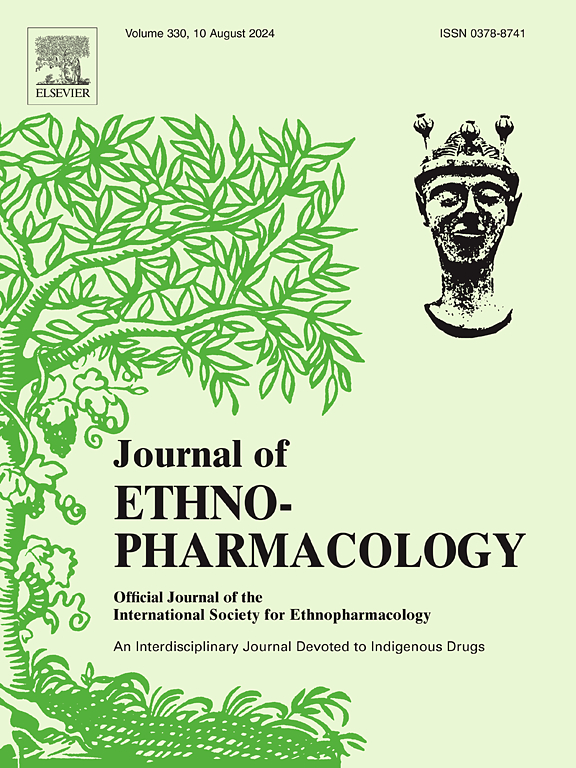在法属圭亚那怀孕期间使用草药贵妇茶及其对健康的影响。
IF 5.4
2区 医学
Q1 CHEMISTRY, MEDICINAL
引用次数: 0
摘要
民族药理学相关性:贵州奥古茶。叶子,在克里奥尔语中fey darjan(“银叶子”)经常被法属圭亚那的妇女引用为分娩相关的做法。虽然这种用途已在几个人种学研究中描述,但这种植物的使用频率尚未量化。此外,除了令人震惊的轶事外,使用者的概况、怀孕期间使用叶子的方式及其对分娩和产后期间的影响仍有待确定。因此,我们的主要目的是估计在分娩的妇女中使用几内亚疟蚊的频率。材料和方法:在卡宴和库鲁的产房进行了一项描述性横断面研究。研究人员在2023年3月21日至7月10日期间收集了332名女性的数据。愿意参与的妇女被多语种卫生工作者邀请回答一份10分钟的结构化定量问卷。对一些护理人员和患者也进行了定性的个人访谈。结果:样品中使用频率为10%。这些叶子通常被用来泡坐浴。使用者一般是出生在法属圭亚那的妇女,她们具有较高的教育水平和社会地位。研究发现,与未使用oguanensis的妇女相比,没有证据表明使用oguanensis的妇女胎儿窘迫或产科并发症增加。结论:本研究未发现桂竹对妊娠结局有显著影响。由于用户样本量小和可能的漏报,本研究可能没有突出法属圭亚那的所有用户资料。即便如此,研究表明,在卡宴和库鲁,使用这种草药的妇女至少有十分之一,因此每年分娩近484次。在产房以外的更大样本上进行的一项补充研究将改进使用频率估计和贵阳疟蚊的用户概况。本文章由计算机程序翻译,如有差异,请以英文原文为准。

Use and health effects of herbal medicine Ocotea guianensis during pregnancy in French Guiana
Ethnopharmacological relevance
Ocotea guianensis Aubl. leaves, in Creole fey darjan (“silver leaves”) are frequently cited by women in French Guiana for childbirth related practices. Although this use has been described in several ethnographic studies, the frequency of use of this plant has not been quantified yet. Moreover, beyond alarming anecdotes, the profile of users, the ways in which leaves are used during pregnancy, and its influence on childbirth and the immediate postpartum period remained to be determined. Our main objective was thus to estimate the frequency of O. guianensis use among women giving birth.
Material and methods
A descriptive cross-sectional study was conducted in the maternity wards of Cayenne and Kourou in the immediate postpartum period. Data were collected from 332 women between March 21 and July 10, 2023. Women willing to participate were invited by multilingual health workers to answer a 10-min structured quantitative questionnaire. Qualitative individual interviews were also conducted with some caregivers and patients.
Results
The frequency of use in the sample was 10 %. The leaves were generally used in the form of a sitz bath. Users were generally women born in French Guiana, with a relatively high level of education and social status. The study found no evidence of an increase in fetal distress or obstetrical complications in women who used O.guianensis compared with those who did not.
Conclusion
The study did not reveal any significant influence of O. guianensis use on pregnancy outcomes. Due to the small sample size of users and potential underreporting, this study may not have highlighted all user profiles in French Guiana. Even so, the study showed that the use of this herbal medicine concerned at least one in 10 women giving birth in Cayenne and Kourou, thus almost 484 deliveries per year. A complementary study conducted on a larger sample beyond maternity wards would refine usage frequency estimates and O. guianensis user profiles.
求助全文
通过发布文献求助,成功后即可免费获取论文全文。
去求助
来源期刊

Journal of ethnopharmacology
医学-全科医学与补充医学
CiteScore
10.30
自引率
5.60%
发文量
967
审稿时长
77 days
期刊介绍:
The Journal of Ethnopharmacology is dedicated to the exchange of information and understandings about people''s use of plants, fungi, animals, microorganisms and minerals and their biological and pharmacological effects based on the principles established through international conventions. Early people confronted with illness and disease, discovered a wealth of useful therapeutic agents in the plant and animal kingdoms. The empirical knowledge of these medicinal substances and their toxic potential was passed on by oral tradition and sometimes recorded in herbals and other texts on materia medica. Many valuable drugs of today (e.g., atropine, ephedrine, tubocurarine, digoxin, reserpine) came into use through the study of indigenous remedies. Chemists continue to use plant-derived drugs (e.g., morphine, taxol, physostigmine, quinidine, emetine) as prototypes in their attempts to develop more effective and less toxic medicinals.
 求助内容:
求助内容: 应助结果提醒方式:
应助结果提醒方式:


